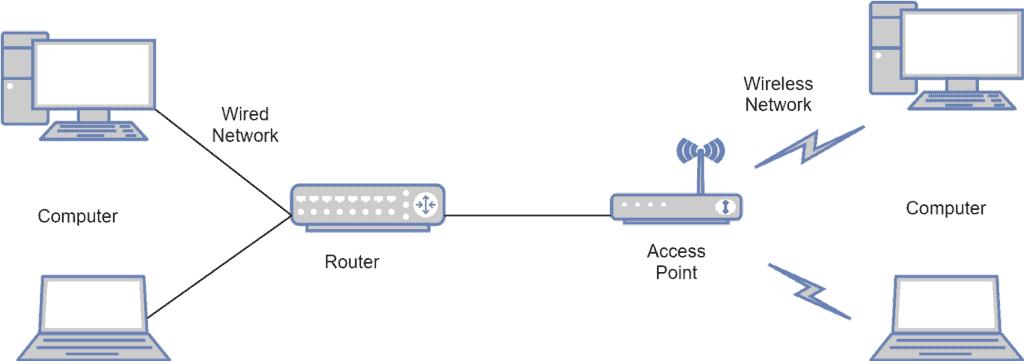1. 概述
计算机网络是由多个设备通过有线或无线方式相互通信组成的系统。这种连接通常由软硬件组件共同实现。
其中,软件层面包括通信协议和操作系统;而硬件层面则包括路由器(Router)、网桥(Bridge)、集线器(Hub)、中继器(Repeater)、网线、交换机(Switch)等。
本文将重点讲解接入点(Access Point)、站点(Station)、网桥(Bridge)和路由器(Router)之间的区别,帮助读者在实际网络部署中做出更合理的选择。
2. 接入点 vs 站点
2.1 接入点(Access Point)
接入点是一种用于连接有线网络与无线网络的设备。它通常通过网线连接到路由器,并广播Wi-Fi信号,供其他无线设备接入:

✅ 作用:扩展无线网络覆盖范围
❌ 无法独立连接互联网,需依赖路由器
2.2 站点(Station)
站点是指能够接入Wi-Fi网络并进行数据收发的设备。它可以是手机、笔记本电脑、平板等终端设备。站点是数据传输的起点或终点:

✅ 作用:作为数据通信的终端设备
⚠️ 注意:站点本身不参与路由或桥接逻辑
3. 网桥 vs 路由器
3.1 路由器(Router)
路由器工作在OSI模型的网络层(Layer 3),负责在源和目标之间进行数据包转发。它通过读取数据包头部信息,决定最佳传输路径:

✅ 作用:跨网络通信、流量控制
✅ 支持NAT、DHCP、防火墙等高级功能
❌ 通常配置较复杂
3.2 网桥(Bridge)
网桥工作在OSI模型的数据链路层(Layer 2),负责在两个网络段之间进行节点级数据传输。它可以把多个局域网段连接成一个逻辑网络:

✅ 作用:连接多个网络段,逻辑上合并成一个网络
❌ 无法处理跨子网通信
4. 四者对比总结
以下表格清晰地展示了接入点、站点、网桥和路由器之间的核心差异:
| 特性 | 接入点 | 站点 | 网桥 | 路由器 |
|---|---|---|---|---|
| 所属 OSI 层级 | 数据链路层 | 应用层 | 数据链路层 | 网络层 |
| 连接方式 | 无线 | 无线 | 有线 | 有线 |
| 使用协议 | LWAPP、CAPWAP、IPP | IEEE 802.11 | STP | RIP、IGRP、OSPF、EGP、EIGRP、BGP、IS-IS |
| 主要功能 | 连接有线与无线网络 | 数据传输/接收终端 | 连接不同网络段为一个网络 | 流量控制、路径选择 |
| 常见品牌示例 | Cisco | Samsung、iPhone、Dell | Cisco、D-Link | Cisco |
5. 总结
本文简要介绍了接入点、站点、网桥和路由器的基本概念与核心差异。理解这些网络设备的功能和适用场景,有助于我们在实际部署中做出更合理的架构设计和选型决策。
✅ 路由器适合跨网络通信
✅ 网桥适合连接多个局域网段
✅ 接入点用于无线扩展
✅ 站点是通信的终端设备
在实际网络部署中,这几种设备常常配合使用,共同构建稳定高效的网络环境。